The Electronic Intifada 1 April 2020
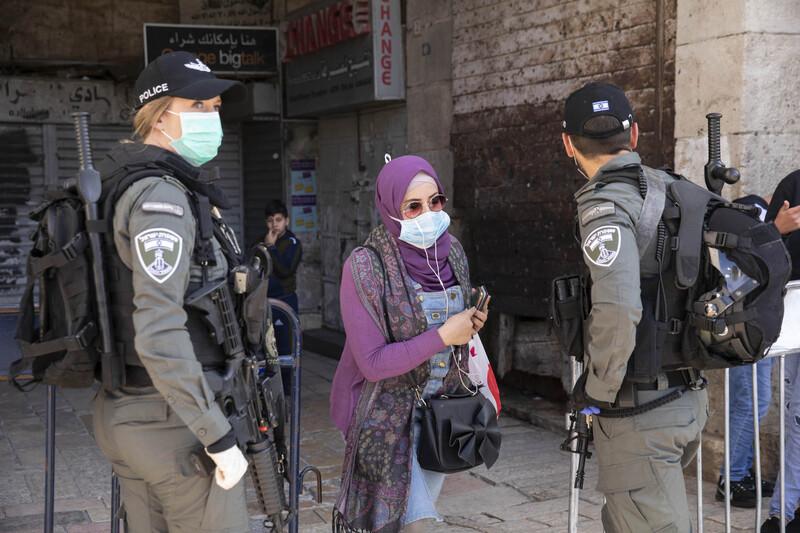
Israeli Border Police control Palestinian movement at a checkpoint at the Damascus Gate to Jerusalem’s Old City as Israel imposed increased restrictions amid the novel coronavirus pandemic on 26 March.
ActiveStillsThe arrival of the coronavirus pandemic in the West Bank and Gaza Strip during March did not spare Palestinians from Israel’s violations of their rights.
There were 134 confirmed cases of COVID-19, the disease caused by the novel coronavirus, in the occupied West Bank and Gaza Strip as of 1 April.
The sole fatality reported by Palestinian authorities in those territories was a woman in the West Bank village of Biddu, who was infected by her son who works in Israel.
A large number of the Palestinians who tested positive for the coronavirus “were infected during work in Israel or Israeli settlements in the West Bank,” according to Euro-Med Monitor.
Coronavirus threats
Twelve coronavirus patients were in quarantine in Gaza as of 31 March and there has been no reports of community spread among the general population so far.
“The capacity of the Palestinian health system to cope with an expected increase in patients remains severely impaired by longstanding challenges and critical shortages, particularly in the Gaza Strip,” the UN humanitarian coordination agency OCHA said.
Human rights groups also warned of the potential spread of COVID-19 among the more than 4,500 Palestinians held in overcrowded Israeli prisons and detention centers.
The Palestinian human rights group Addameer stated on 1 April that a former Palestinian prisoner who was arrested by Israel on 18 March, held at Ofer prison in the West Bank, and released on 31 March tested positive for the coronavirus.
Israel has reported more than 5,100 confirmed cases of the novel coronavirus and 21 deaths. Benjamin Netanyahu, Israel’s prime minister, has consolidated his control as the country reels from the outbreak.
There have been more than 823,600 confirmed cases of the novel coronavirus in 205 countries, areas or territories worldwide and some 40,600 deaths.
According to the UN humanitarian coordination agency OCHA, the relatively low number of confirmed cases in the Palestinian territories “may reflect the limited testing capacity.”
Palestinians killed in West Bank
Israeli forces killed two Palestinians in the West Bank during the month amid the pandemic.
Muhammad Abdelrahim Hamayel, 15, died after he was shot in the head with live ammunition fired by Israeli soldiers in Beita village near the city of Nablus on 11 March.
The teenager was injured in the early morning hours as villagers confronted Israeli forces accompanying a group of Israeli settlers touring a nearby archaeological site.
He is the second Palestinian child killed by Israeli forces so far this year.
The second Palestinian killed during the month, Sufian Khawaja, was shot in the head in the West Bank village of Nilin on 22 March. The Israeli army claimed that Khawaja was hurling stones at vehicles when he was shot dead.
Israel is withholding Khawaja’s body.
Israeli forces continued to raid Palestinian communities in the West Bank as they struggled to hold back the threat from the coronavirus pandemic.
Soldiers also demolished and seized structures meant for a field clinic in the West Bank’s Jordan Valley.
Human rights groups said that Israel’s heightened restrictions amid the coronavirus are hindering their ability to monitor and document violations of Palestinians’ rights.

Abdelrahman Shtaiwi, 9, with his mother at their home in the northern West Bank village of Kafr Qaddum on 3 March. The child was shot in the head with live ammunition fired by Israeli soldiers in the village in July last year and remains immobile and unable to speak.
ActiveStills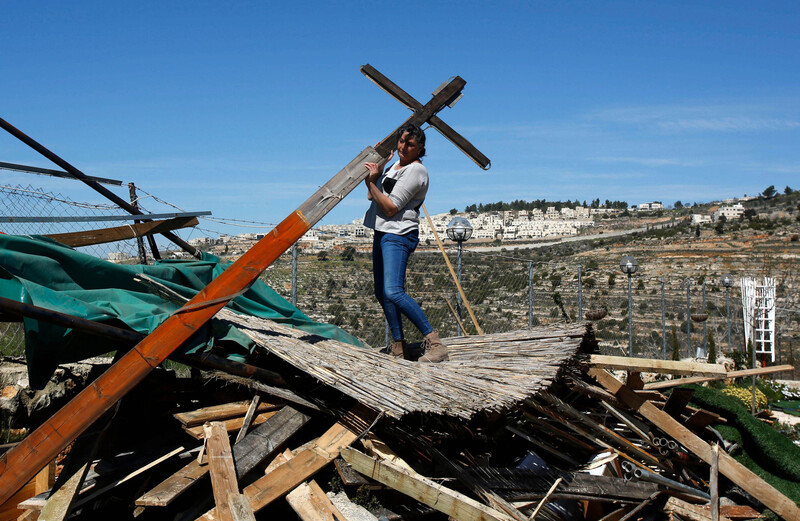
A Palestinian woman carries a metal structure after her family’s restaurant was demolished by Israeli forces in the town of Beit Jala, near the West Bank city of Bethlehem, on 4 March. Israel issued a demolition order on the pretext that the restaurant was built without a permit, which Israel rarely grants to Palestinians in areas of the West Bank under its full military control.
WAFA
Tourists wear masks as they visit the Church of the Nativity in the West Bank city of Bethlehem on 5 March. The church was closed the following day after workers at a nearby hotel tested positive for coronavirus.
APA images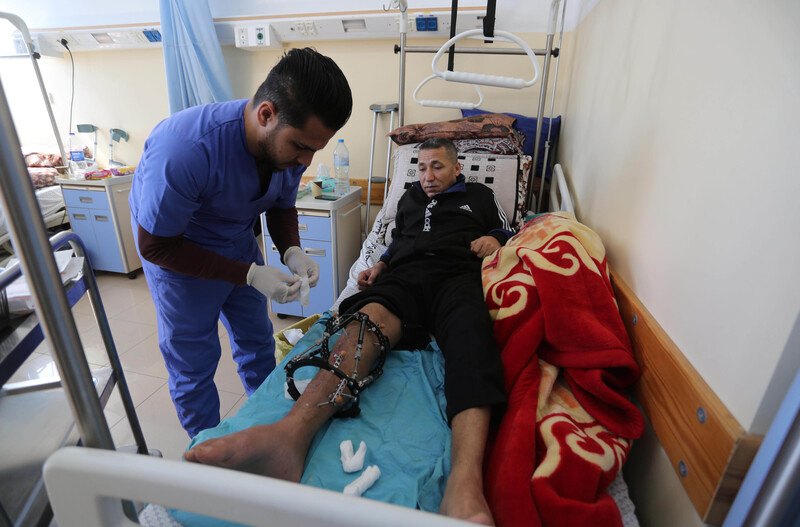
Palestinians who lost limbs after being injured by Israeli forces are treated at a limb reconstruction center in Khan Younis, southern Gaza, on 5 March.
APA images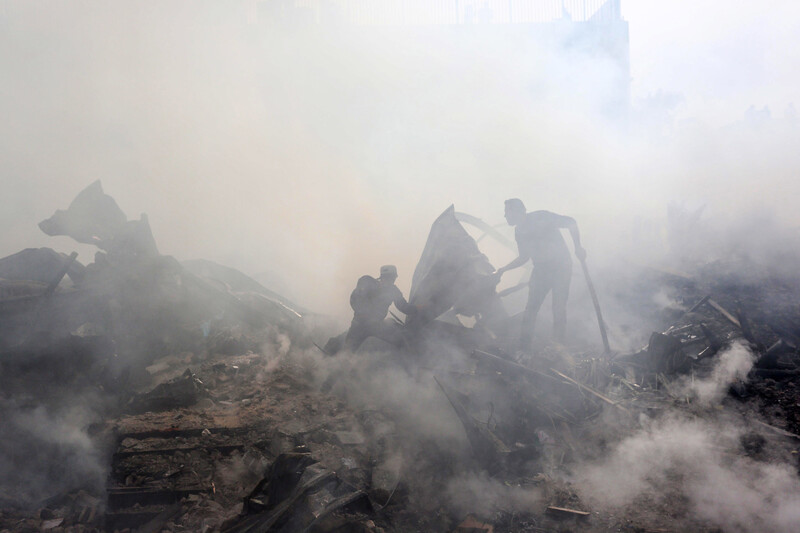
Palestinians gather at a market where an explosion caused a deadly fire in Nuseirat refugee camp, central Gaza Strip, 5 March.
APA images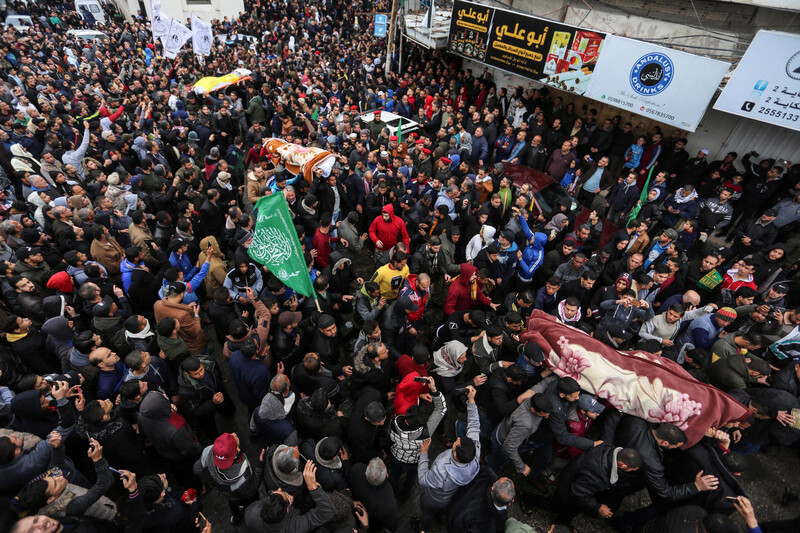
Mourners carry the bodies of Palestinians who died in a fire at a market in Nuseirat refugee camp, central Gaza Strip, on 6 March. At least 16 people suffered fatal injuries as a result of the fire, including six children. The human rights group Al Mezan pointed to poor safety and enforcement practices leading to the deadly incident.
APA images
Mai Qudaih picks tomatoes at her farm in Khan Younis, southern Gaza Strip, on 8 March.
APA images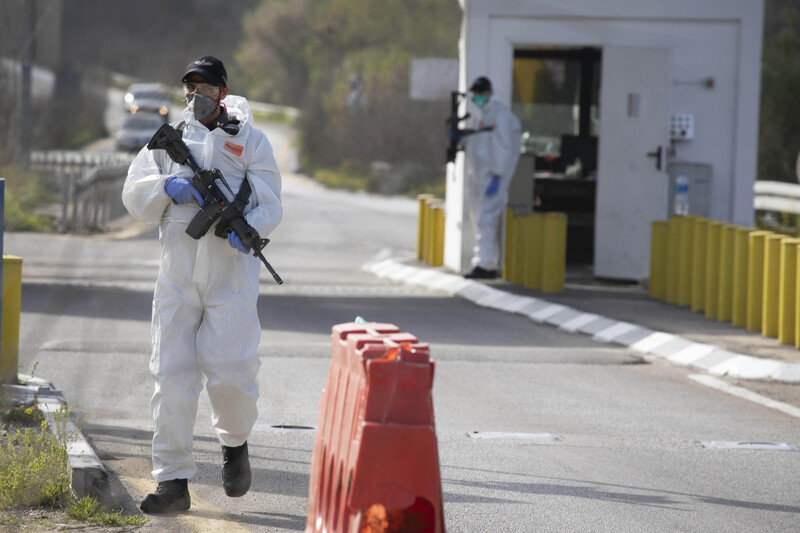
Israeli Border Police soldiers wear protective gear at al-Walaja checkpoint between the West Bank cities of Bethlehem and Jerusalem on 10 March.
ActiveStills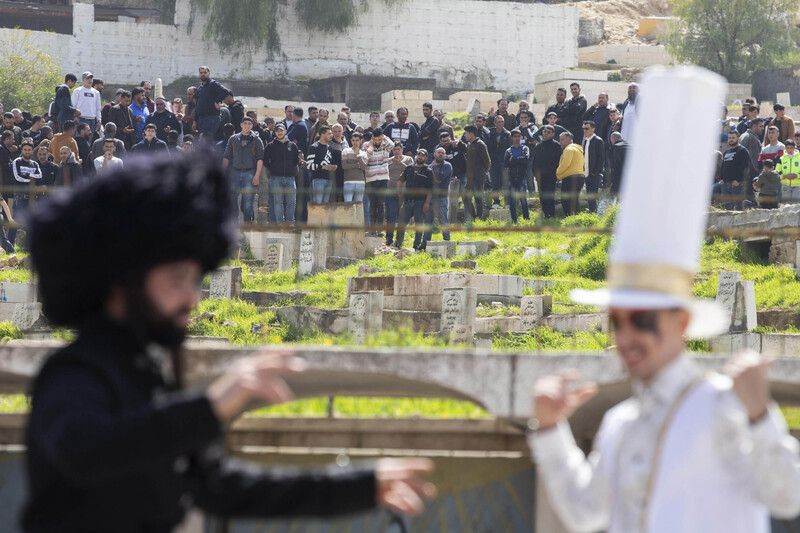
Palestinians look on as Israeli settlers in costume hold a parade to mark Purim on Hebron’s Shuhada Street in the West Bank city of Hebron on 10 March, despite the spread of the novel coronavirus. Shuhada Street has closed to Palestinians after an American-born Israeli settler massacred worshippers at Hebron’s Ibrahimi mosque in 1994.
ActiveStills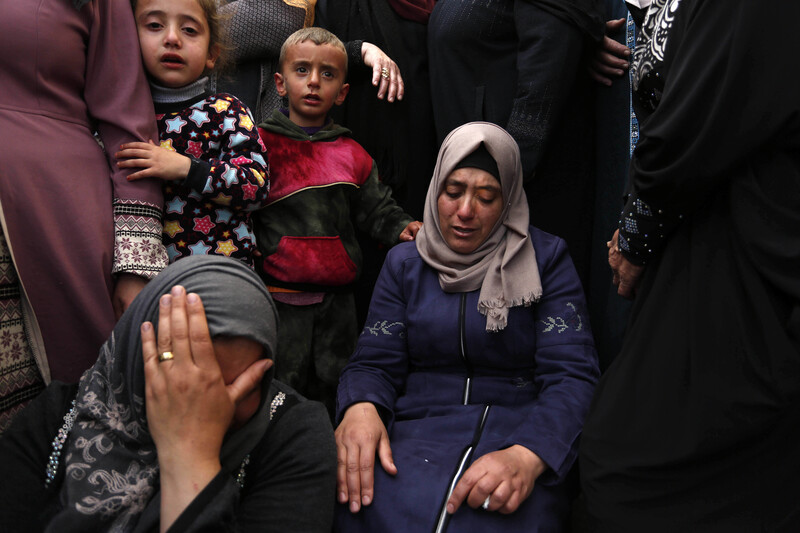
Relatives of Muhammad Hamayel, 15, mourn during his funeral in Beita village, south of the West Bank city of Nablus, on 11 March. The teen was killed by Israeli soldiers who had raided the village earlier that morning.
APA images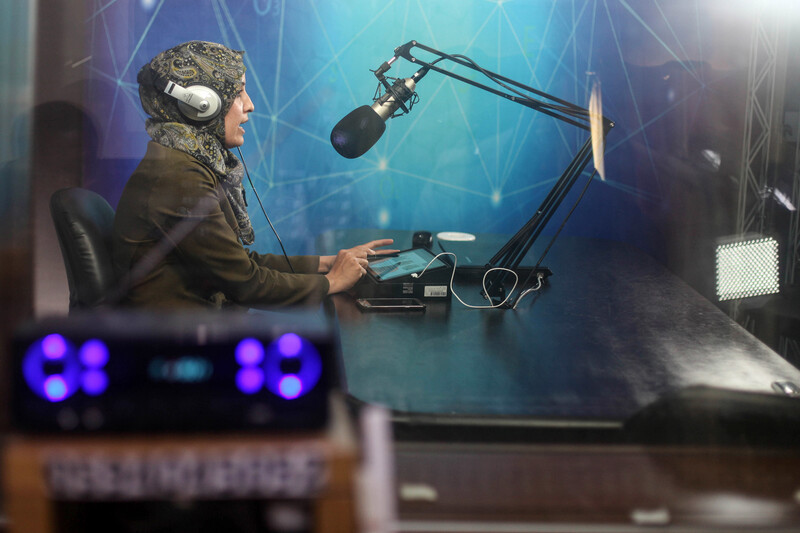
A Palestinian teacher broadcasts an electronic lesson as students stay at home to halt the spread of the novel coronavirus, Gaza City, 15 March.
APA images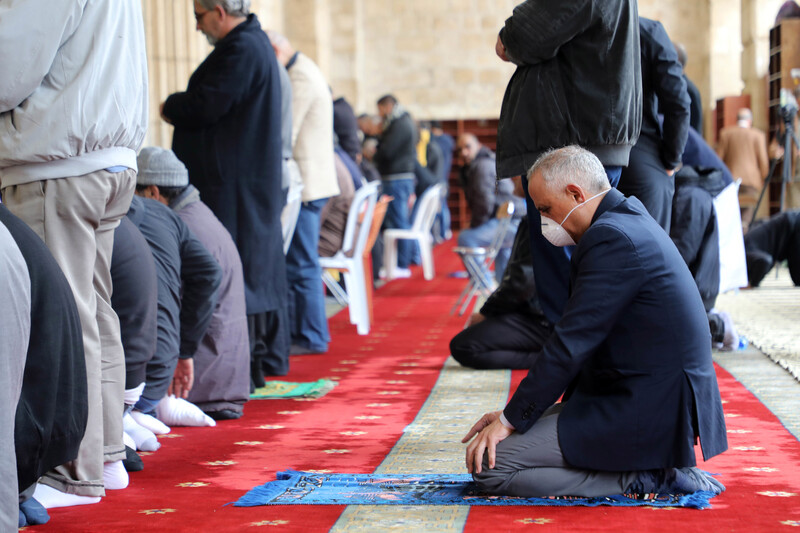
A Palestinian man wearing a mask prays at Jerusalem’s al-Aqsa mosque compound on 15 March.
APA images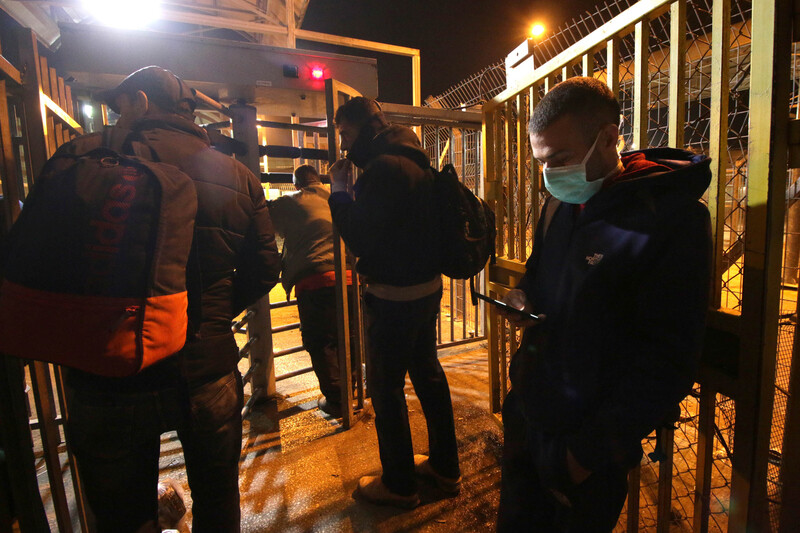
Palestinian workers queue at the crowded Eyal military checkpoint near the West Bank town of Qalqilya on their way to their workplaces in Israel on 16 March.
ActiveStills
Palestinian workers manufacture disinfectants at a chemical agent factory in Gaza City on 17 March.
APA images
UNRWA staff prepare to receive respiratory patients at a Gaza City school turned into a makeshift clinic on 18 March as part of preparations to receive, examine and isolate potential COVID-19 patients.
APA images
Palestinians play volleyball at a school turned into a quarantine center in Deir al-Balah, central Gaza Strip, on 21 March.
APA images
A Gaza City wedding hall sits empty as gatherings are banned to halt the spread of the novel coronavirus on 22 March. Authorities in Gaza confirmed the first two cases of the disease caused by the novel coronavirus, identifying them as Palestinians who had traveled to Pakistan and were being held in quarantine since their return.
APA images
Building continues in Israeli settlements despite the novel coronavirus pandemic, including in the Brukhin settlement, photographed on 22 March.
ActiveStills
Palestinians wearing protective masks relax next to the beach in Gaza City amid the novel coronavirus pandemic on 25 March.
ActiveStills
Palestinians look out of their rooms at a Gaza City school where they are being quarantined on 26 March.
ActiveStills
The usually bustling Damascus Gate to Jerusalem’s Old City sits empty on 27 March.
ActiveStills
A major thoroughfare in Gaza City is nearly empty as authorities in Gaza imposed measures to halt the spread of the novel coronavirus in the territory, 27 March. The UN warned that a COVID-19 outbreak in Gaza would be disastrous, given the high poverty rates and weak health system in the territory, which has been under a severe Israeli blockade since 2007.
APA images
Palestinian workers make protective medical suits at a sewing factory amid precautions against the spread of the novel coronavirus in Gaza City on 28 March.
ActiveStills
Palestinian artists paint a mural as part of a campaign to raise awareness about the novel coronavirus in Khan Younis, southern of Gaza Strip, on 28 March.
APA images
A Palestinian woman smokes a water pipe at her home in the West Bank city of Nablus during a confinement order to halt the spread of the novel coronavirus, 29 March.
APA images
Palestinian farmers harvest almonds in Khan Younis, southern Gaza Strip, on 29 March.
APA images
Palestinian workers spray disinfectant to combat the spread of the novel coronavirus in al-Bureij refugee camp, central Gaza Strip, on 30 March.
APA images
Palestinians commemorate Land Day near the Gaza-Israel boundary east of Gaza City as mass rallies were canceled due to the spread of the novel coronavirus, 30 March. Land Day commemorates six Palestinians who were killed during protests against Israeli land confiscation in the Galilee in 1976 and serves as an ongoing expression of Palestinians’ attachment to their land and determination to regain their rights.
APA images
Palestinians display coronavirus-themed cakes at their shop in Khan Younis, southern Gaza, on 31 March.
APA images
UNRWA staff prepare food aid rations to be delivered to the homes of refugee families, instead of distributed at a UN center, due to the novel coronavirus pandemic, in Deir al-Balah, central Gaza Strip, on 31 March.
APA images

